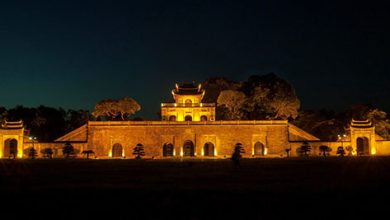Research and Experimental Practices of the Ancient Thang Long’s Royal Tet Festivities at the Imperial Citadel of Thang Long – Hanoi
In the effort to preserve and promote the traditional cultural values of humanity, UNESCO has, over the past few decades, shown significant interest in the field of intangible cultural heritage. In 2003, UNESCO announced the Convention for the Safeguarding of Intangible Cultural Heritage and the registration of intangible cultural heritage masterpieces by various countries. Vietnam, as a member, signed UNESCO’s Convention for the Safeguarding of the Intangible Cultural Heritage and has implemented numerous programs aimed at preserving and promoting intangible cultural heritage. In 2001, the Cultural Heritage Law passed by the National Assembly of the Socialist Republic of Vietnam, for the first time, included a chapter on Protecting and Promoting Intangible Cultural Heritage.
The most basic characteristic of intangible cultural heritage is that it exists primarily in non-material forms, beyond specific physical objects (excluding some forms that have been documented). It lies dormant in human memory and consciousness, manifesting only through human behavior and activities within a specific performative environment.
Preserving intangible cultural heritage requires urgent attention due to the risk of rapid loss in the face of industrialization and modernization. At the World Heritage Site of the Thang Long – Hanoi Imperial Citadel, research, preservation, and promotion of intangible cultural heritage values are also emphasized. Since its inscription in 2010, the Thang Long – Hanoi Heritage Conservation Center has actively advanced the research of the Thang Long Imperial Palace’s intangible cultural heritage, achieving significant initial successes. Among these, the intangible culture of the royal court is considered foundational for reviving and highlighting heritage. This rich court culture includes rituals, festivals, games, performances, etc., epitomizing the nation’s cultural essence. Some springtime royal rituals have been studied and experimentally implemented through various forms of interpretive exhibitions and ritual reenactments, both serving tourists and contributing effectively to the preservation and promotion of the cultural values of 1,000 years of Thang Long-Hanoi.
The Nguyen Dan Festival, starting from the end of the Chạp month [the 12th month of the lunar calendar] of the old year to the Giêng month [the 1st month of the lunar calendar] of the new year, was marked in the ancient Thang Long Imperial Citadel by a series of unique spring royal rituals such as the Táo Quân (also known as Kitchen Gods) offering ceremony, calendar presenting ceremony, Spring Buffalo procession, sealing (closing) ceremony, neu pole erecting and lowering ceremonies, and royal seal opening ceremony.
Táo Quân Offering Ceremony
The worship of Ông Công and Ông Táo is an ancient custom in Vietnam. According to legend, Ông Công is the deity governing the land within the household, while Ông Táo represents three kitchen guardians. Ông Công and Ông Táo are believed to have been sent by the Jade Emperor to the mortal world to observe and record the good and evil deeds of humans. Annually, on the 23rd day of the Chạp month, these deities are said to ride carp to Heaven to report the year’s deeds, good and bad, to the Jade Emperor for judgment.
Moreover, in the Vietnamese psyche, the imagery of “a fish leaping over the Dragon Gate” or “a carp transforming into a dragon” symbolizes transcendence and represents the spirit of overcoming difficulties, perseverance, and the relentless pursuit of knowledge leading to success. It is emblematic of an inherent noble character or striving towards a favorable outcome.
According to tradition, the 23rd day of Chạp is when Ông Táo bids farewell as he returns to Heaven to report the household’s affairs to the Jade Emperor. Both in folk custom and in the royal court, offerings are prepared for this occasion.
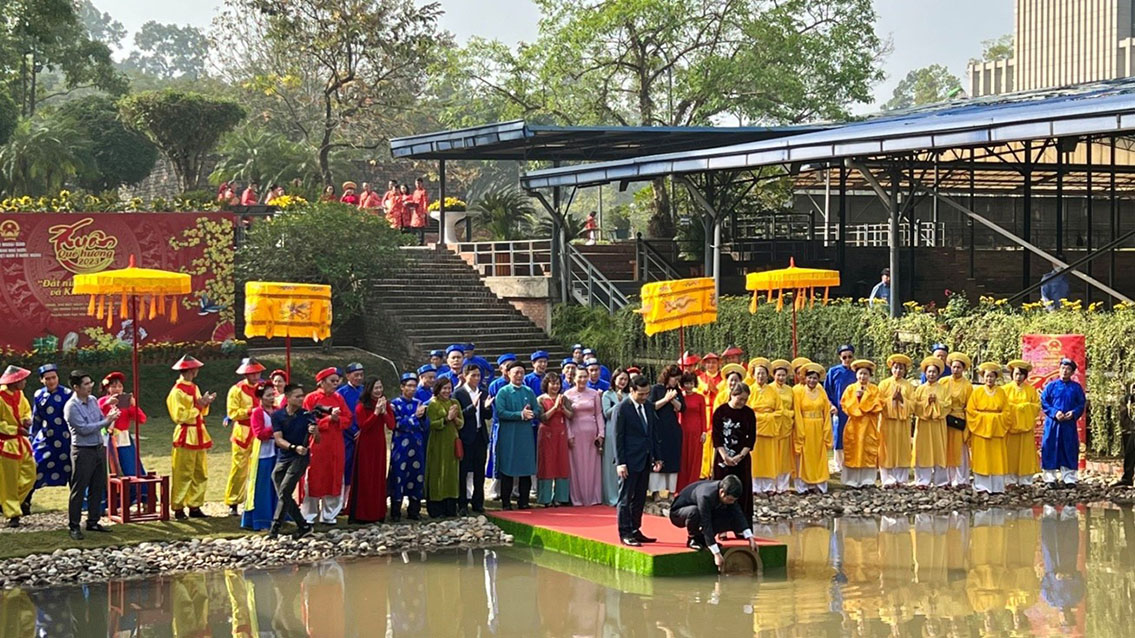
Carp releasing ritual at the ancient river at the Archaeological Site 18 Hoang Dieu
Calendar Presenting Ceremony
In the Eastern feudal dynasties, the emperor was regarded as the “Son of Heaven,” acting as the intermediary between heaven and the people. Therefore, he had the responsibility to create and announce the calendar to inform the public about time and weather, assisting them in agricultural activities, and ritual observances, and stabilizing their lives. As early as the Ly Dynasty, observatories were built for astronomical observations and timekeeping. Annually, on the 24th day of the Chạp month, the court conducted the Calendar Presentation Ceremony to present the Royal Calendar to the emperor and distribute it among officials and localities.
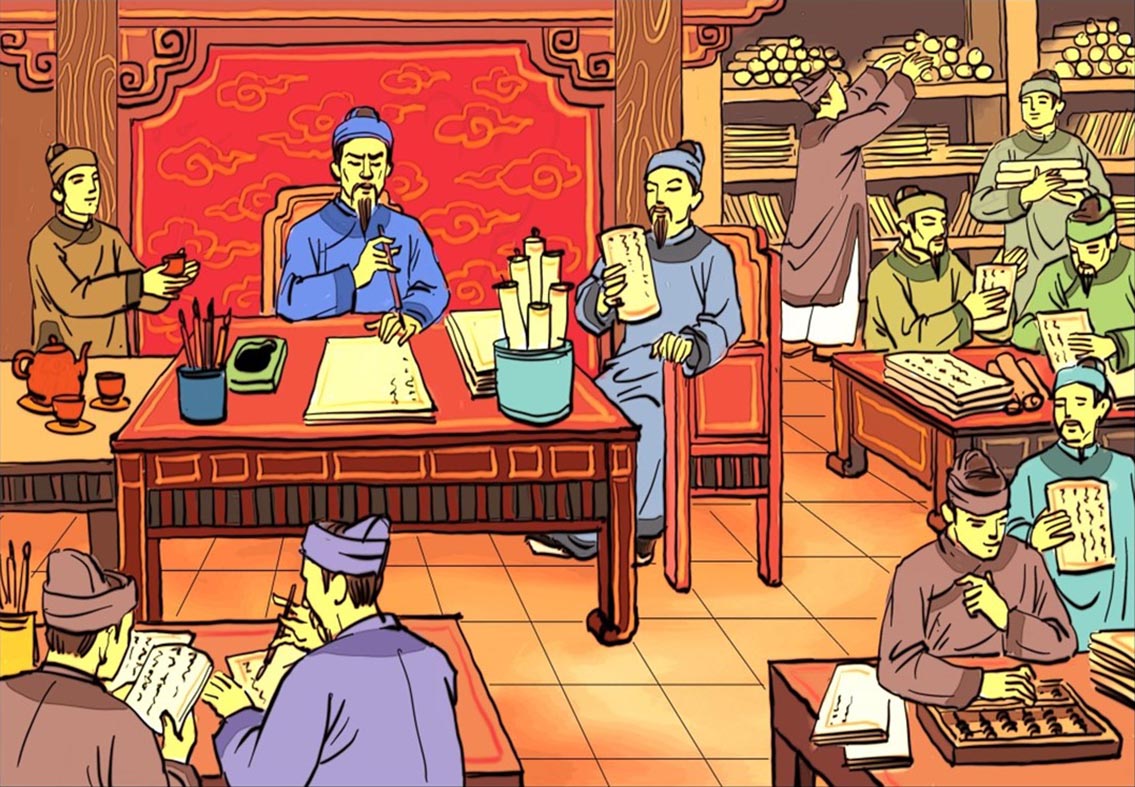
Illustrative Image: The Tư Thiên Giám Compiling the Calendar

Illustrative Image: A Tư Thiên Giám Official Presenting the Royal Calendar
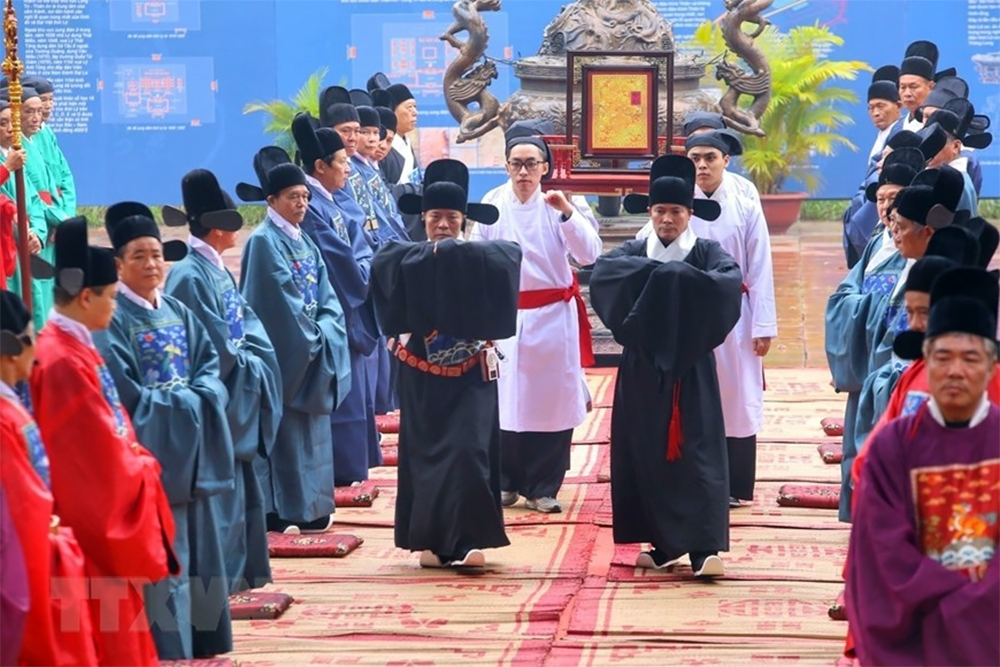
Ritual Reenactment: Calendar Presentation Ceremony
- Spring Buffalo Procession Ceremony
The Spring Buffalo Procession during the Revival Lê dynasty was a significant ritual, embodying both royal and folk characteristics. The court meticulously prepared it and solemnly held it on the day of Lập Xuân (Start of Spring). The ceremony involved the offering of an earthen ox in spring, symbolizing the expulsion of the cold air. Annually, during the spring season, the Center reenacts this ritual: the Spring Buffalo is paraded from the Doan Mon gate to the courtyard of the Kinh Thien Palace and the Spring Buffalo is presented to the officials.
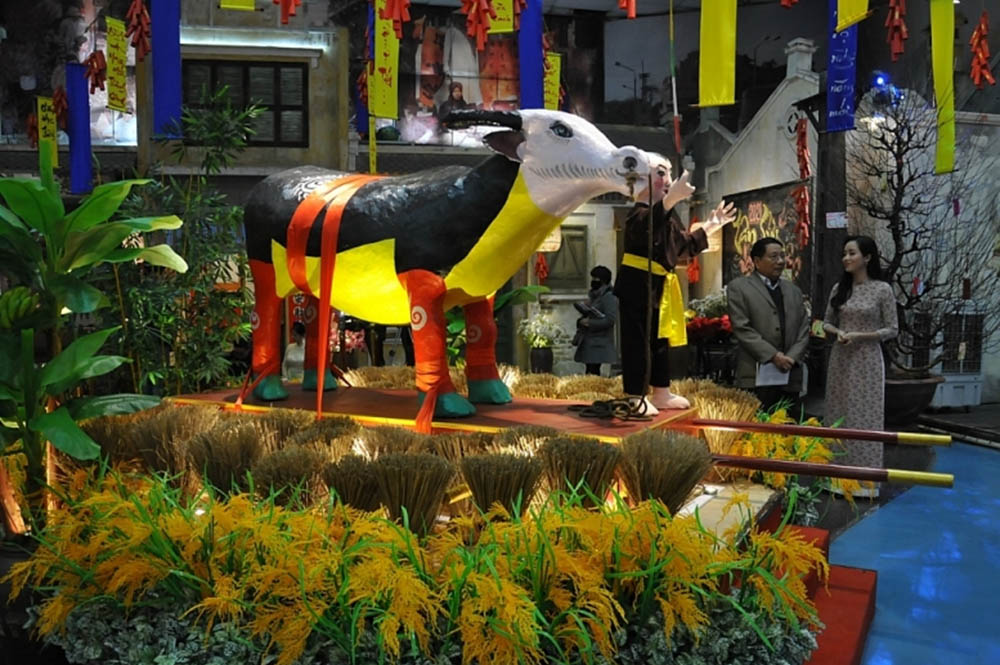
Model Reconstruction: Spring Buffalo
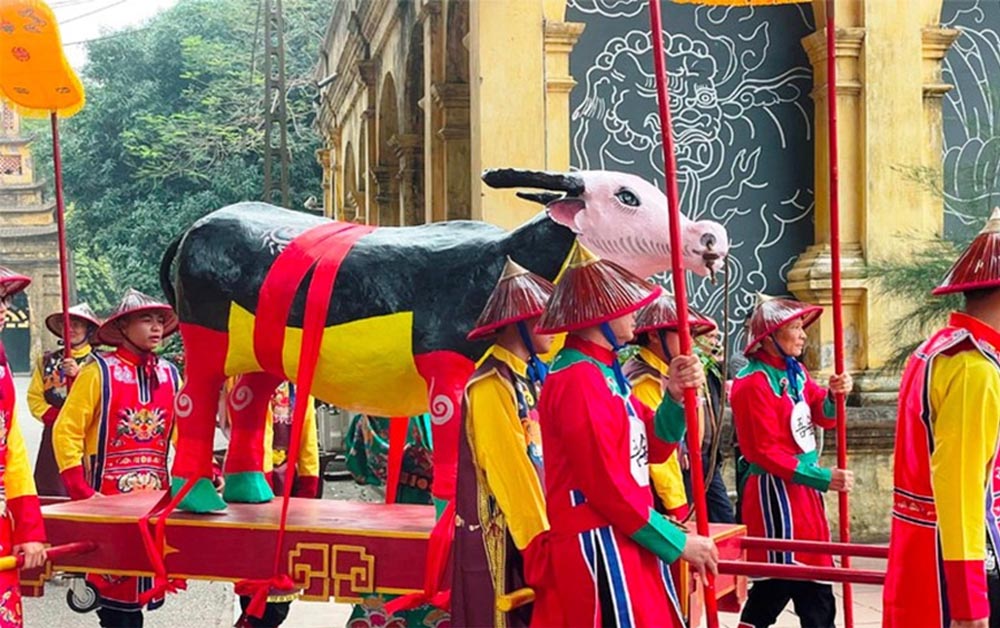
The Ritual of Parading the Spring Buffalo into the Courtyard of Kinh Thien Palace
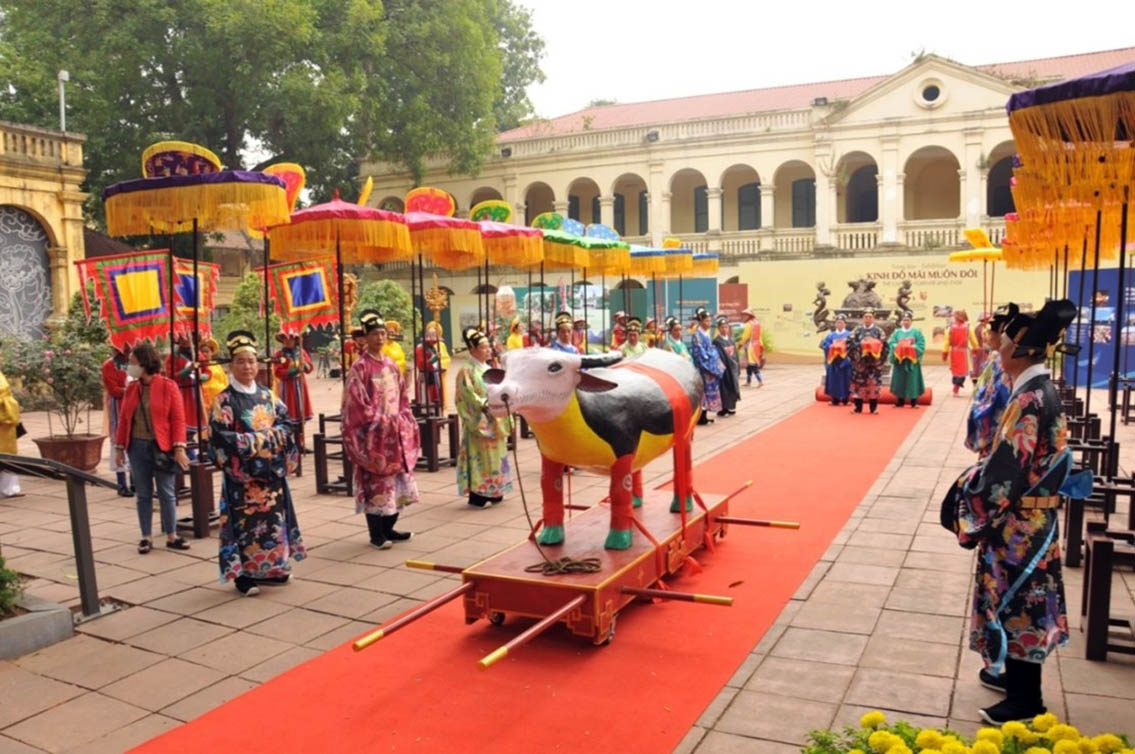
Reenactment of the Spring Buffalo Procession Ceremony
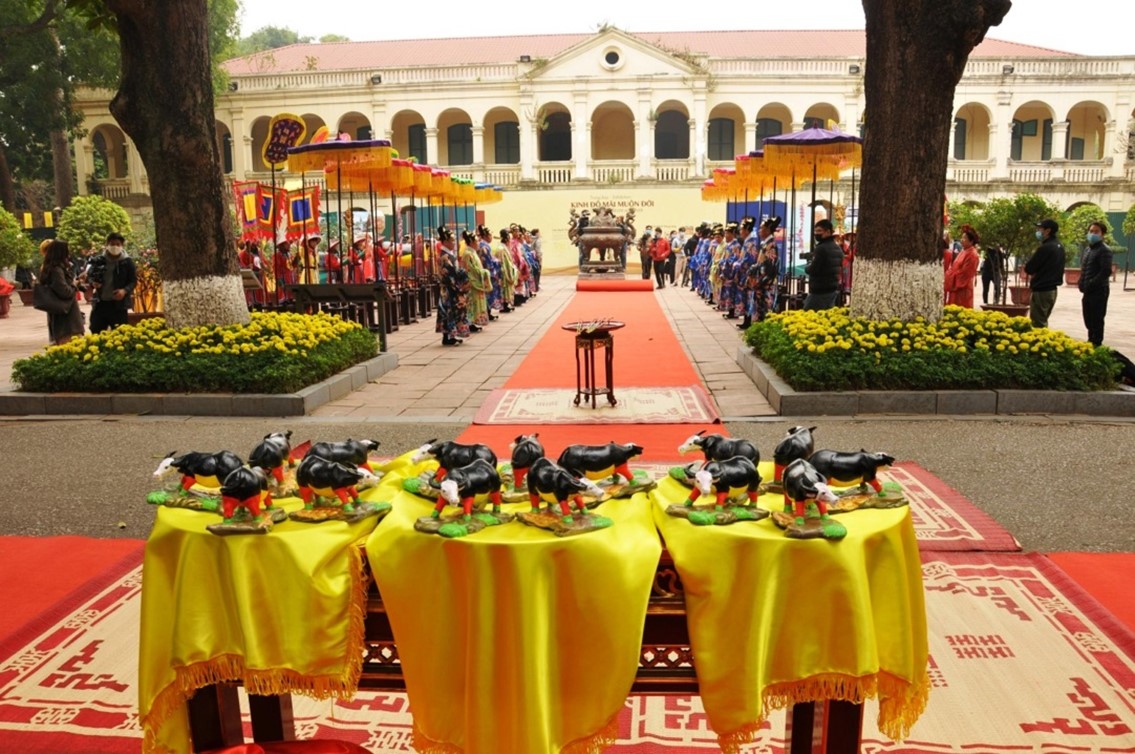
Miniature Model of Spring Buffalo in Ritual Reenactment

Performing the ritual of “whipping the Spring Buffalo”
‘Neu’ Pole Erecting and Lowering Ceremonies
The Neu Pole Erecting Ceremony, a crucial ritual of the royal court, was an essential part of the Tet Nguyen Dan (Lunar New Year) celebrations, documented since the Revival Le dynasty. Historical records indicate that on the 30th day of the Chạp month, the ceremonial neu pole was first erected in the royal palace, lord’s residences, and homes of officials before being set up in civilian households. On the 7th day of the first lunar month, within the imperial palace, the court held a ceremony called the Lowering of the Neu Pole.
As has become an annual tradition, on the 23rd day of Chạp month, the Center, along with visitors, joyfully conducts the Neu Pole Erecting Ceremony at the Doan Mon gate, followed by the Neu Lowering Ceremony on the 7th day of Tet.

Ritual Offering to Deities Before Erecting the Neu Pole at Thang Long Imperial Citadel
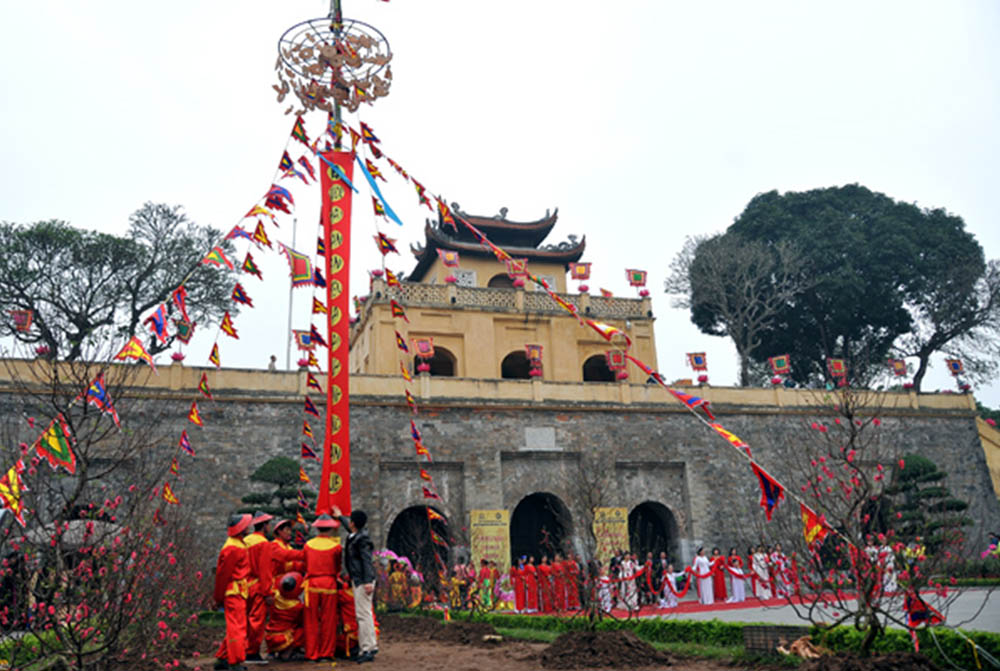
The Neu Pole in front of Doan Mon Gate

The Neu Pole Lowering Ceremony at Thang Long Imperial Citadel
Research, preservation, and promotion of the intangible cultural values of the royal court are extremely necessary, contributing to the construction of a unique image and identity for the heritage site of Thang Long Imperial Citadel, laying the foundation for tourism development.


